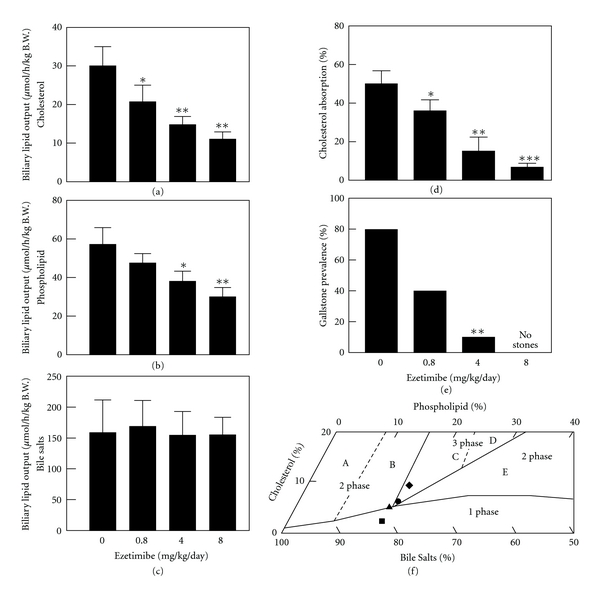Figure 3.

Effect of ezetimibe on the prevention of cholesterol gallstones. Ezetimibe significantly reduced, in a dose-dependent fashion, hepatic output of (a) biliary cholesterol and (b) phospholipid, but not (c) bile salts. *P < 0.05, **P < 0.01, and ***P < 0.001, compared with mice fed the lithogenic diet and receiving no ezetimibe. (d) There is a clear dose-dependent reduction in intestinal cholesterol absorption efficiency from 50 ± 6% to 4 ± 2% in chow-fed with mice, as measured by the fecal dual-isotope ratio method. (e) When doses of ezetimibe are increased from 0 to 4 mg/kg/day, gallstone prevalence rates are reduced from 80% to 10% in mice fed with the lithogenic diet for 8 weeks. No gallstones are found in mice treated with ezetimibe at 8 mg/kg/day. (f) The relative lipid composition of pooled gallbladder bile from mice fed with the lithogenic diet and receiving no ezetimibe are located in the central three-phase zone, where bile is composed of solid cholesterol monohydrate crystals, liquid crystals, and saturated micelles at equilibrium. In contrast, administration of the highest dose (8 mg/kg/day) of ezetimibe resulted in the relative biliary lipid composition of pooled gallbladder bile plotted in the one-phase micellar zone, even upon the lithogenic diet feeding for 8 weeks. By phase analysis, these bile samples are composed of unsaturated micelles at equilibrium. A symbol ♦ represents relative lipid composition of pooled gallbladder bile at 8 weeks on the lithogenic diet supplemented with ezetimibe at 0; ● 0.8; ▲ 4; ■ 8 mg/kg/day. Reproduced with modifications and with permission from [15].
